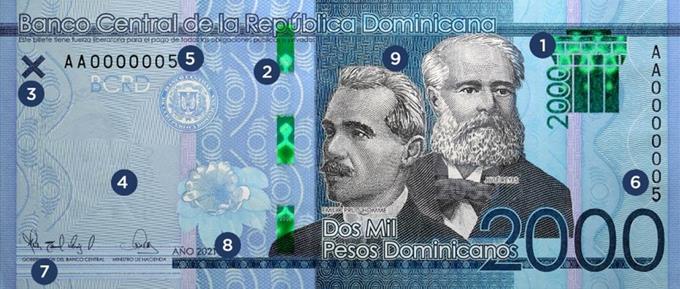The Central Bank (BCRD) reported today that when a RD$2,000 bill is circulated irregularly reported, citizens should take a little time to verify whether it is false or not, with the measures it recommends and which are set out below:
Isotype with the visual identity of the BCRD: accompanied by the value of the denomination in numerical characters, which change from green to blue, printed with optically variable magnetic ink that has a droplet effect and gives the sensation of undulating sand.
- security thread: with a change from green to blue, which presents the effect of drops and gives the sensation of undulating sand. This thread is combinable with the isotype of the institutional visual identity.
- Mark for the blind: geometric figure (X) in high relief located on the edge of the upper left corner.
- Watermark: image of the patrician Juan Pablo Duarte, which can be seen by holding the bill up to the light. Duarte is incorporated into the mass of the paper, accompanied by the value of the denomination “2000”, vertically and to the right. Behind Duarte’s image, you can see the figure of a curve or “S”, made up of many points or pixels.
- Horizontal numbering: identification number of each ticket, located on the upper left side, next to the mark for the blind. This numbering is the same as the vertical numbering.
- Vertical numbering: identification number of each ticket, located on the right side. This numbering must be the same as the horizontal numbering.
- Microprints: inscriptions in very small letters, which at first glance appear to be a solid line, but which can be appreciated with the help of a magnifying glass.
- Year of printing: located at the bottom of the front of the banknote, it allows us to identify the series to which it belongs, that is, in what year it was manufactured.
- Latent image: small inverted lines forming an engraving with the initials “BCRD”. It can be seen when the banknote is viewed at a certain angle, with the help of light.
The BCRD urges citizens to consult the information available on its website if they have any questions about this or any bill or coin issued by the Central Bank. www.bancentral.gov.do or in their institutional social networks.
Candida Acosta
Santo Domingo, DR
The Central Bank (BCRD) reported today that when a RD$2,000 bill is circulated irregularly reported, citizens should take a little time to verify whether it is false or not, with the measures it recommends and which are set out below:
- Isotype with the visual identity of the BCRD: accompanied by the value of the denomination in numerical characters, which change from green to blue, printed with optically variable magnetic ink that has a droplet effect and gives the sensation of undulating sand.
- security thread: with a change from green to blue, which presents the effect of drops and gives the sensation of undulating sand. This thread is combinable with the isotype of the institutional visual identity.
- Mark for the blind: geometric figure (X) in high relief located on the edge of the upper left corner.
- Watermark: image of the patrician Juan Pablo Duarte, which can be seen by holding the bill up to the light. Duarte is incorporated into the mass of the paper, accompanied by the value of the denomination “2000”, vertically and to the right. Behind Duarte’s image, you can see the figure of a curve or “S”, made up of many points or pixels.
- Horizontal numbering: identification number of each ticket, located on the upper left side, next to the mark for the blind. This numbering is the same as the vertical numbering.
- Vertical numbering: identification number of each ticket, located on the right side. This numbering must be the same as the horizontal numbering.
- Microprints: inscriptions in very small letters, which at first glance appear to be a solid line, but which can be appreciated with the help of a magnifying glass.
- Year of printing: located at the bottom of the front of the banknote, it allows us to identify the series to which it belongs, that is, in what year it was manufactured.
- Latent image: small inverted lines forming an engraving with the initials “BCRD”. It can be seen when the banknote is viewed at a certain angle, with the help of light.
The BCRD urges citizens to consult the information available on its website if they have any questions about this or any bill or coin issued by the Central Bank. www.bancentral.gov.do or in their institutional social networks.
